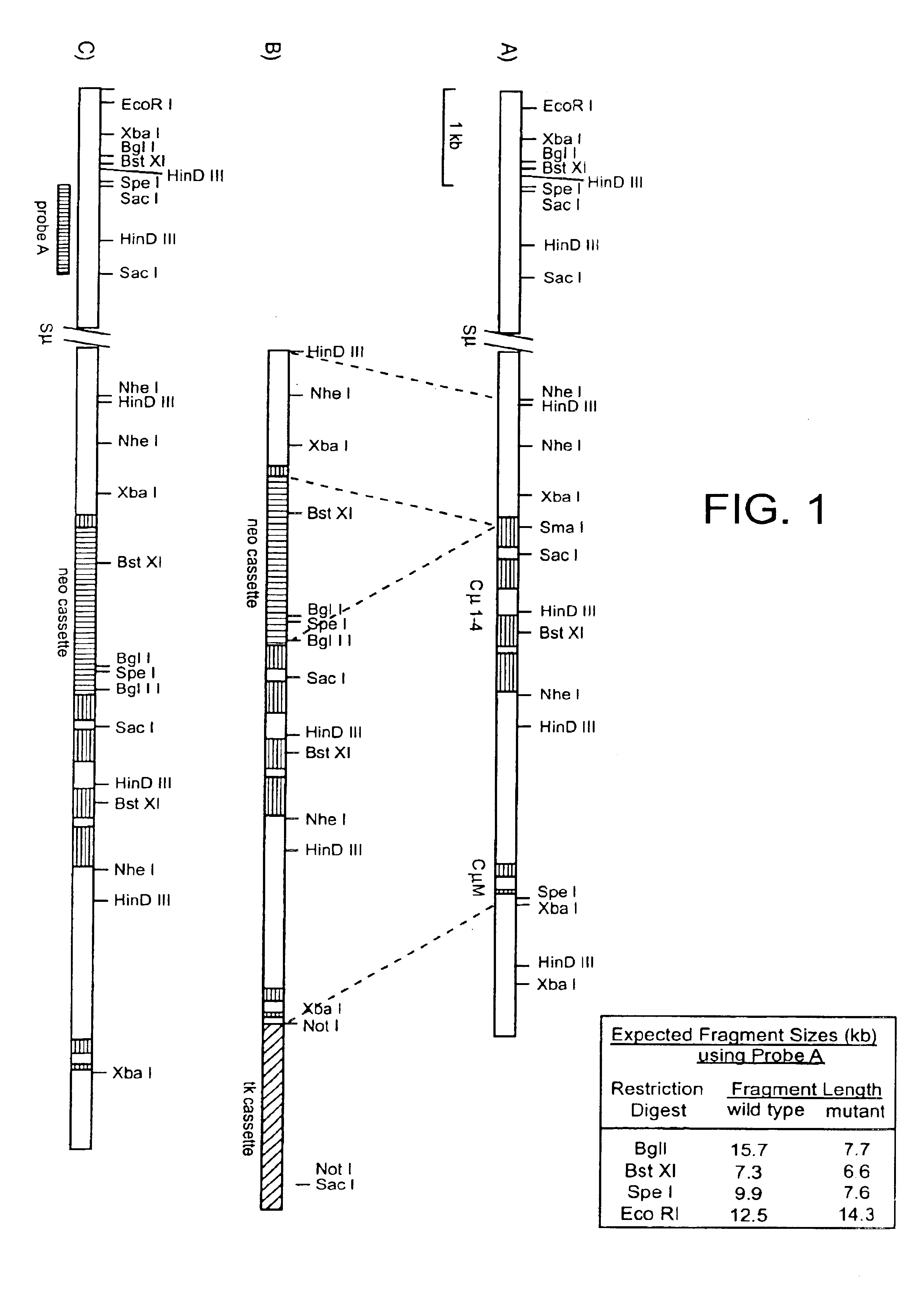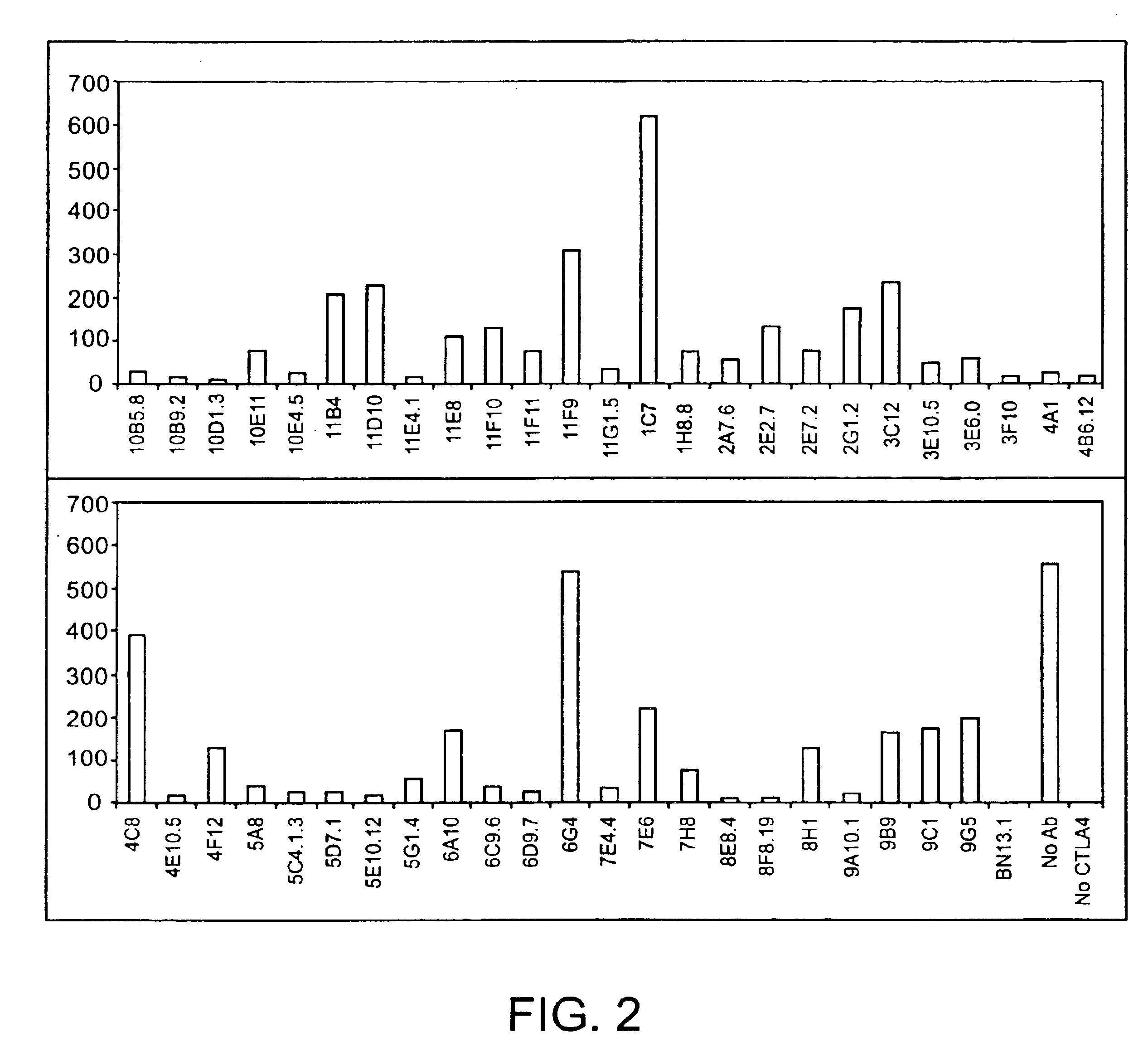Human CTLA-4 antibodies
a technology of human ctla4 and antibodies, applied in the field of molecular immunology and the treatment of human diseases, can solve the problems of clonal inactivation or anergy, acute toxicity,
- Summary
- Abstract
- Description
- Claims
- Application Information
AI Technical Summary
Benefits of technology
Problems solved by technology
Method used
Image
Examples
example 1
Generation of Cmu Targeted Mice Construction of a CMD Targeting Vector
[0270]The plasmid pICEmu contains an EcoRI / XhoI fragment of the murine Ig heavy chain locus, spanning the mu gene, that was obtained from a Balb / C genomic lambda phage library (Marcu et al. Cell 22: 187, 1980). This genomic fragment was subcloned into the XhoI / EcoRI sites of the plasmid pICEMI9H (Marsh et al.; Gene 32, 481-485, 1984). The heavy chain sequences included in pICEmu extend downstream of the EcoRI site located just 3′ of the mu intronic enhancer, to the XhoI site located approximately 1 kb downstream of the last transmembrane exon of the mu gene; however, much of the mu switch repeat region has been deleted by passage in E. coli.
[0271]The targeting vector was constructed as follows (see FIG. 1). A 1.3 kb HindIII / SmaI fragment was excised from pICEmu and subcloned into HindIII / SmaI digested pBluescript (Stratagene, La Jolla, Calif.). This pICEmu fragment extends from the HindIII site located approximate...
example 2
Generation of HCo12 Transgenic Mice The HCo12 Human Heavy Chain Transgene
[0280]The HCo12 transgene was generated by coinjection of the 80 kb insert of pHC2 (Taylor et al., 1994, Int. Immunol., 6: 579-591) and the 25 kb insert of pV×6. The plasmid pV×6 was constructed as described below.
[0281]An 8.5 kb HindIII / SalI DNA fragment, comprising the germline human VH1-18 (DP-14) gene together with approximately 2.5 kb of 5′ flanking, and 5 kb of 3′ flanking genomic sequence was subcloned into the plasmid vector pSP72 (Promega, Madison, Wis.) to generate the plasmid p343.7.16. A 7 kb BamHI / HindIII DNA fragment, comprising the germline human VH5-51 (DP-73) gene together with approximately 5 kb of 5′ flanking and 1 kb of 3′ flanking genomic sequence, was cloned into the pBR322 based plasmid cloning vector pGP1f (Taylor et al. 1992, Nucleic Acids Res. 20: 6287-6295), to generate the plasmid p251f. A new cloning vector derived from pGP1f, pGP1k (Seq. ID #1), was digested with EcoRV / BamHI, and l...
example 3
Generation of Human IgG Kappa Anti-Human CTLA-4 Monoclonal Antibodies
[0282]A DNA segment encoding a fusion protein comprising sequences from the human CTLA-4 and the murine CD3zeta genes was constructed by PCR amplification of cDNA clones together with bridging synthetic oligonucleotides. The encoded fusion protein contains the following sequences: i human CTLA-4 encoding amino acids 1-190 (containing the signal peptide, the extracellular domain of human CTLA-4 and the entirety of the presumed transmembrane sequence of human CTLA-4) and ii. murine CD3zeta from amino acid 52 to the carboxy terminus (Weissman et al. (1988) Science 239: 1018-1021). The amplified PCR product was cloned into a plasmid vector and the DNA sequence was determined. The cloned insert was then subcloned into the vector pBABE (which contains a gene encoding for puromycin resistance (Morganstern, JP and Land, H Nucl. Acids Res. 18: 3587-96 (1990)) to create pBABE-huCTLA-4 / CD3z. pBABE-huCTLA-4 / C...
PUM
| Property | Measurement | Unit |
|---|---|---|
| temperature | aaaaa | aaaaa |
| temperature | aaaaa | aaaaa |
| pH | aaaaa | aaaaa |
Abstract
Description
Claims
Application Information
 Login to View More
Login to View More - R&D
- Intellectual Property
- Life Sciences
- Materials
- Tech Scout
- Unparalleled Data Quality
- Higher Quality Content
- 60% Fewer Hallucinations
Browse by: Latest US Patents, China's latest patents, Technical Efficacy Thesaurus, Application Domain, Technology Topic, Popular Technical Reports.
© 2025 PatSnap. All rights reserved.Legal|Privacy policy|Modern Slavery Act Transparency Statement|Sitemap|About US| Contact US: help@patsnap.com



